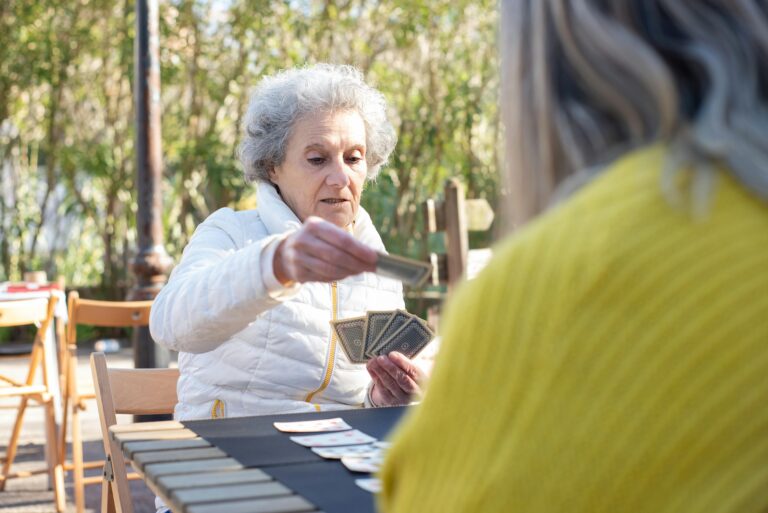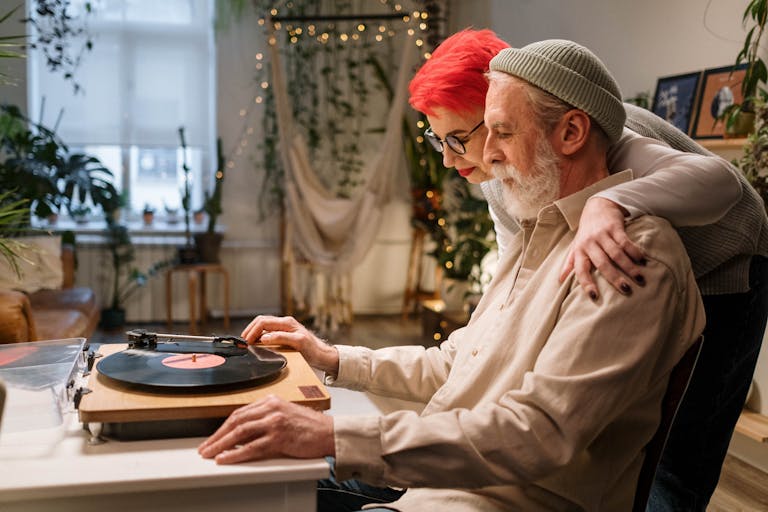The Power of Storytelling: Preserving Legacy Through Resident Narrative
You’ll find immense power in storytelling within senior communities as it preserves legacies through resident narratives you might not have heard. By listening to their unique journeys, you’re honoring their past and affirming their value. Sharing stories builds trust, empathy, and bonds among neighbors, combating loneliness. It creates a safe space to capture memories for future generations using technology or creative expression. Stick around to uncover even more about this heartfelt connection.
Key Takeaways
- Storytelling preserves residents’ legacies by capturing unique life experiences and wisdom.
- Personal narratives foster emotional connections and strengthen community bonds.
- Listening to stories honors residents’ past and affirms their value.
- Technology aids in recording and sharing narratives for future generations.
- Creative expression through art or writing enriches storytelling efforts.
The Importance of Personal Narratives in Senior Communities

As you step into senior communities, you’ll quickly notice the power of personal narratives in fostering connection and preserving identity. Each story shared by a resident carries a lifetime of experiences, wisdom, and lessons. When you listen, you’re not just hearing tales; you’re honoring their past and affirming their value. Your role in encouraging these narratives can make a profound difference.
Take time to sit with them, ask meaningful questions, and show genuine interest. You’ll see how sharing their journey helps them feel seen and respected. By creating a safe space for their voices, you’re helping preserve their legacy. The strong community spirit at places like Garden Ridge Place enhances these storytelling opportunities, allowing residents to engage with one another and share their experiences.
Your attentive ear becomes a bridge, ensuring their stories endure and continue to inspire within the community.
How Storytelling Strengthens Bonds Among Residents
Look around a senior community, and you’ll see that storytelling does more than preserve individual legacies; it weaves a tight-knit fabric of connection among residents.
When you listen to a neighbor share tales of their past, you’re not just hearing stories—you’re building trust and empathy. These moments create a shared space where everyone feels valued and understood.
Encourage residents to open up, and you’ll witness barriers dissolve. As you facilitate these exchanges, you’re fostering friendships that combat loneliness.
Organize storytelling circles, and watch residents laugh, cry, and connect over shared experiences. By nurturing this environment, you’re helping build a community where everyone belongs, strengthening bonds that enrich lives and create a true sense of family among neighbors. Celebrating these stories enhances emotional enrichment, reinforcing the importance of connection and shared experiences among residents.
Capturing Memories to Honor Individual Histories

While storytelling builds community, capturing memories assures that individual histories aren’t lost to time.
You have the power to make a difference by sitting with residents and listening to their unique journeys. Ask thoughtful questions about their past—childhood adventures, cherished traditions, or defining moments—and write down their words.
These stories matter, and your effort guarantees they endure. Additionally, creating a digital memory album can further enhance the storytelling experience by preserving these narratives for future generations.
The Role of Technology in Preserving Life Stories
Let’s explore how technology amplifies your efforts in safeguarding personal histories. You can use digital tools like voice recorders and video cameras to capture residents’ stories with clarity and emotion.
Store these precious narratives on secure cloud platforms or external drives, ensuring they’re protected for future generations. Apps and software make it easy to organize and transcribe recordings, so you’re not bogged down by manual tasks.
Share these stories through online portals or social media, connecting families and communities to cherished memories. By embracing technology, you’re not just preserving legacies; you’re making them accessible and meaningful. Additionally, regular interaction through communication tools enhances the emotional well-being of residents, fostering deeper connections with their loved ones.
Immerse yourself in these tools, and you’ll find new ways to honor and serve others through the power of shared life stories.
Encouraging Participation Through Creative Expression

Immerse yourself in the power of creative expression to inspire participation in preserving life stories. You’ve got the chance to help others share their journeys through art, music, or writing. Encourage residents to paint memories, sing old songs, or jot down cherished tales. These activities aren’t just fun; they’re a bridge to connect hearts and capture legacies.
Dive in by organizing workshops or casual gatherings where everyone feels safe to express themselves. Offer gentle prompts like, “What’s a moment that shaped you?” Listen actively and celebrate each contribution. Your role is to spark joy and trust, ensuring every voice matters. By fostering creativity, you’re not just recording history—you’re honoring lives with compassion and care.
Additionally, consider incorporating volunteer opportunities to enhance social connections and make the process even more enriching for everyone involved.
Building a Shared Heritage Within Living Spaces
How can you transform living spaces into a tapestry of shared heritage? Start by inviting residents to contribute personal artifacts or mementos that reflect their unique histories. Display these treasures in common areas, creating a visual story that binds everyone together. You’re not just decorating; you’re weaving a collective identity.
Next, organize storytelling circles right in these spaces. Encourage each person to share a memory tied to their displayed item. As you listen and connect, you’re fostering a sense of belonging.
Consider labeling these artifacts with short descriptions, so even quiet moments in the space educate and inspire. By nurturing these shared environments, you’re building a living legacy that honors every individual while uniting the community in profound ways. Additionally, this approach aligns with the family-centered care approach we embrace, enhancing emotional well-being and community connections.
The Emotional Impact of Listening and Sharing Tales

Why does sharing a personal story feel so powerful? When you open up about your life, you’re not just recounting events—you’re forging a deep connection. Your words can touch hearts, stirring empathy and understanding in those who listen.
As you share, you invite others to feel your joys and sorrows, creating a bond that transcends mere conversation.
When you listen to someone’s tale, you’re offering a priceless gift. You’re saying, “I see you, and your story matters.” This act of presence can heal wounds and build trust. Additionally, the outdoor experiences associated with storytelling can enhance emotional well-being and foster deeper connections among listeners.
Frequently Asked Questions
What Challenges Arise in Storytelling Sessions?
When leading storytelling sessions, you’ll face challenges like emotional barriers or memory gaps that can hinder sharing.
Don’t worry, though; you can gently encourage openness with patience and empathy.
You might also struggle with time constraints or differing group dynamics.
Stay flexible, adapt to their pace, and create a safe space.
You’re helping others preserve precious stories, so keep listening actively and guide them with compassion every step.
How Often Should Storytelling Events Occur?
How often should storytelling events occur?
You’ve got to find a rhythm that keeps everyone engaged without overwhelming them. Aim for once a month—it’s frequent enough to build connection and anticipation, yet gives you time to plan meaningful sessions.
Listen to participants’ feedback; if they’re enthusiastic for more, adjust accordingly. You’re serving their needs, so prioritize what fosters joy and community while ensuring everyone feels heard and valued.
Who Facilitates Resident Storytelling Activities?
Hey, have you ever wondered who facilitates resident storytelling activities? You’re the heart of this process!
As a caregiver or community leader, you guide these sessions with warmth and patience. You’ll encourage residents to share their tales, ensuring they feel heard.
Don’t hesitate to involve volunteers or family members too—they can help spark memories. Together, you’re creating a space where every story matters and lives on through connection.
What Training Do Storytelling Facilitators Need?
Hey, if you’re wondering what training storytelling facilitators need, let’s explore!
You’ve gotta build skills in active listening, so you can truly hear others’ stories. Learn techniques for guiding conversations with empathy, ensuring everyone feels safe sharing.
Don’t skip on cultural sensitivity training; it’s key to respecting diverse backgrounds.
Finally, practice storytelling methods to help others express their truths. You’re shaping connections, so train with heart and purpose!
How Are Storytelling Conflicts Resolved?
When resolving storytelling conflicts, you’ve got to step in with empathy and patience.
Listen actively to each person’s perspective, ensuring everyone feels heard. Encourage open dialogue, helping them find common ground or compromise.
Don’t shy away from mediating tough emotions—your role is to guide, not judge.







